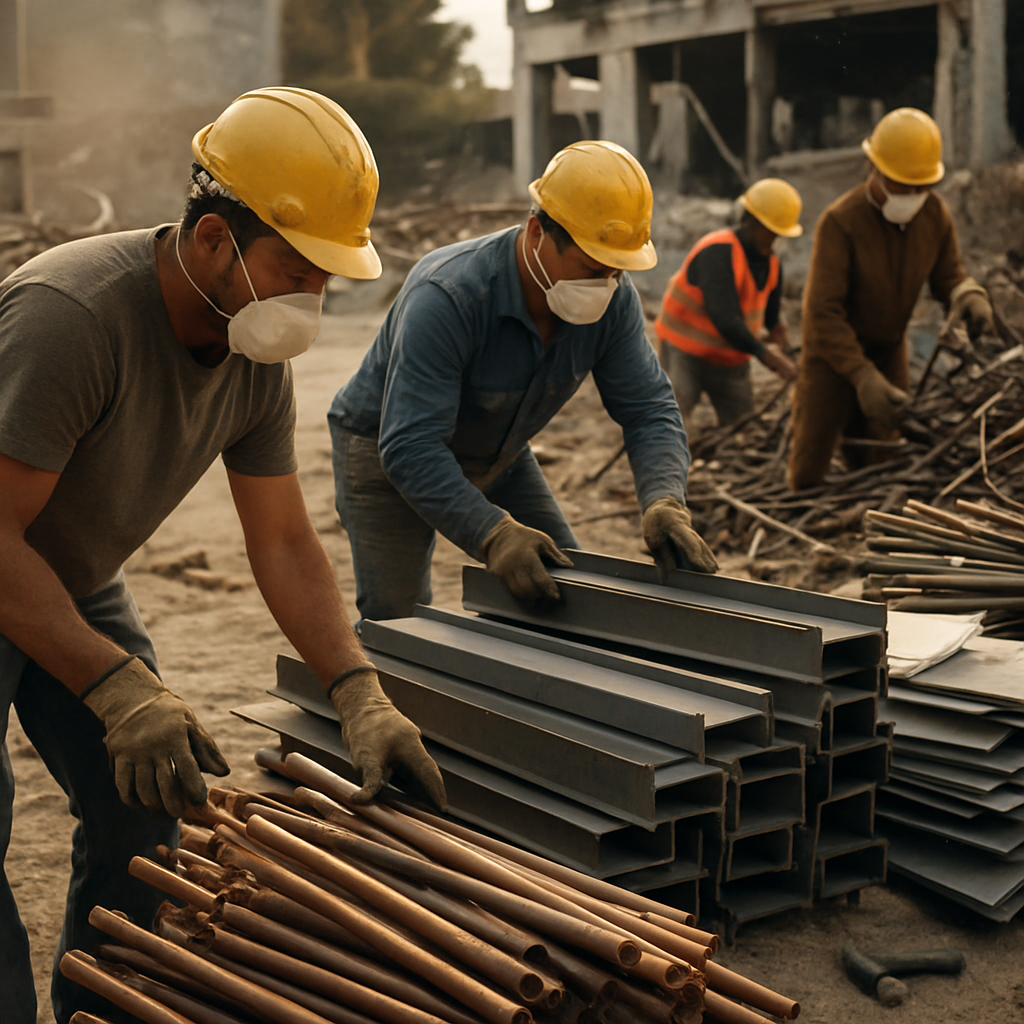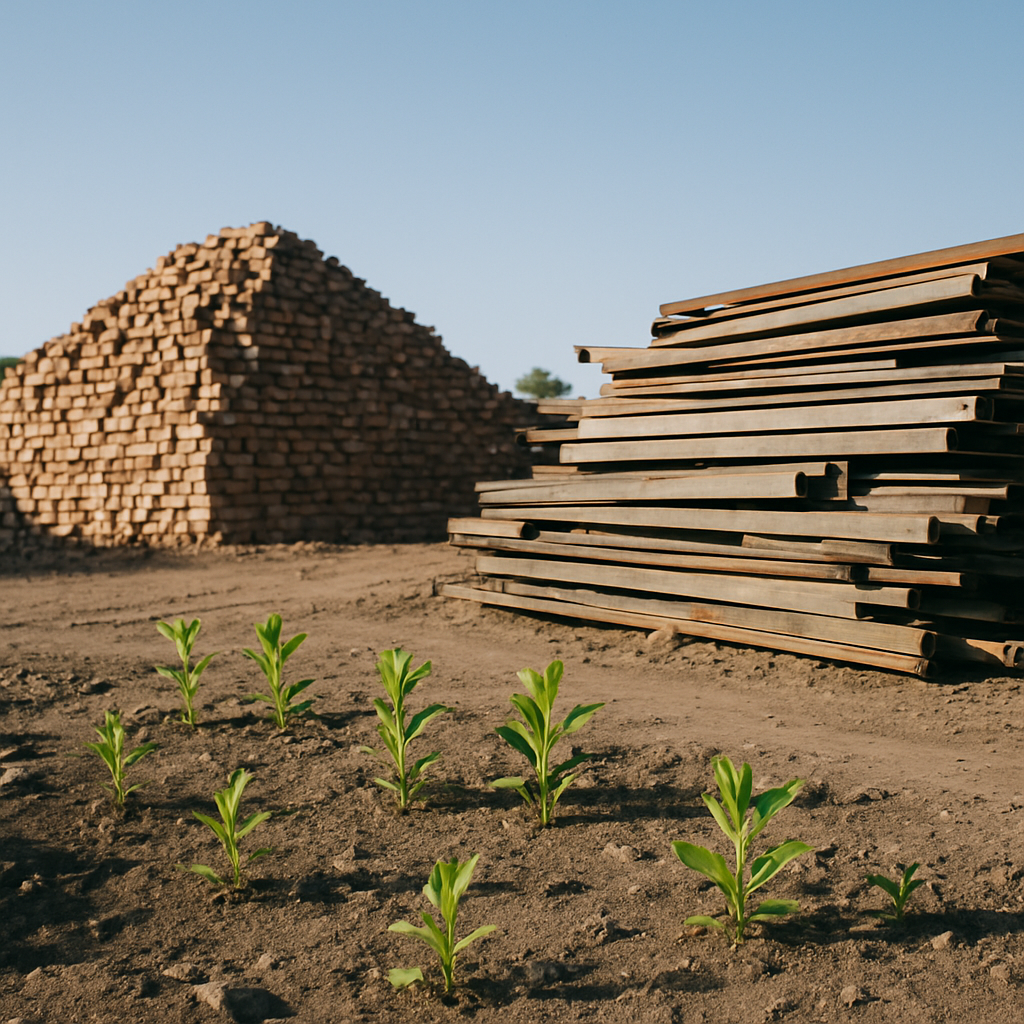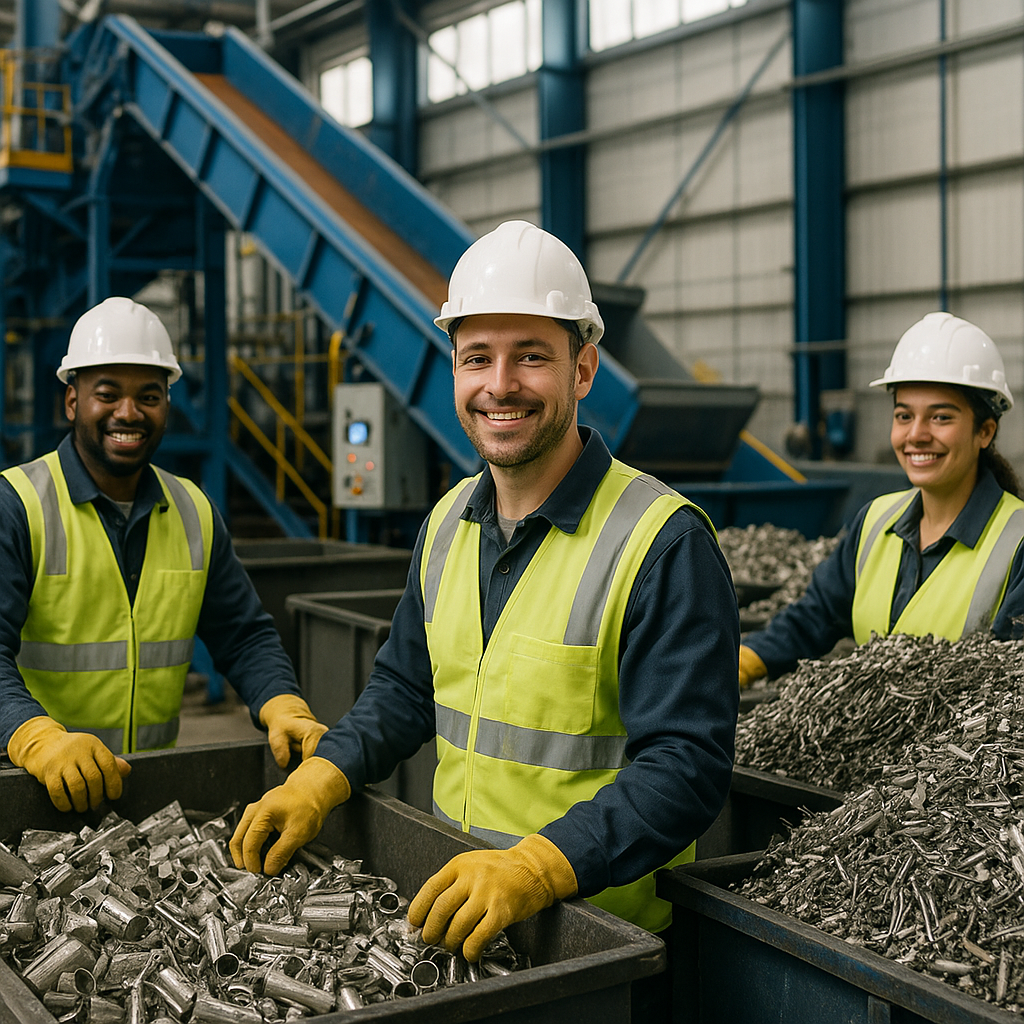5901 Botham Jean Blvd, Dallas, TX 75215
Demolition Scrap Metal Recycling: What’s Recyclable, What Pays, What to Avoid
September 4, 2025The crash of crumbling concrete and the screech of twisted metal mark the start of a demolition project where valuable resources are waiting to be recovered. Demolition scrap metal recycling transforms what was once considered waste into a sustainable resource stream.
Demolition scrap metal recycling is the systematic process of identifying, collecting, and processing metal materials salvaged from building demolition projects. This includes structural steel, copper wiring, aluminum siding, HVAC components, plumbing pipes, and various other metal elements present in buildings and structures.
The process begins at the demolition site, where trained workers identify and separate different types of metals from other construction debris. These metals are then sorted by type, processed, and prepared for reintroduction into the manufacturing cycle. This practice represents a critical shift from traditional demolition methods that prioritized speed over material recovery.
What Types of Metals Are Commonly Found in Demolition Projects?

Demolition projects yield two main categories of scrap metal: ferrous and non-ferrous. Understanding the difference between these metal types is essential for maximizing recycling value and ensuring proper handling during the demolition process.
Ferrous Metals in Demolition
Ferrous metals contain iron as their primary component. These metals are magnetic and generally have excellent tensile strength, making them ideal for structural applications. In demolition sites, ferrous metals are abundant and typically make up the bulk of recyclable materials by weight.
Common ferrous metals found in demolition projects include structural steel beams, rebar used in concrete reinforcement, corrugated iron roofing, steel frames, girders, and columns. These components are typically found in the skeletal structure of commercial buildings, bridges, and industrial facilities.
While ferrous metals are strong and durable, they have a significant drawback: they rust when exposed to moisture. This susceptibility to corrosion is why many structural ferrous components in older buildings may show signs of degradation over time.
Non-Ferrous Metals in Demolition
Non-ferrous metals do not contain iron as their main component. These metals are not magnetic, tend to be more lightweight, and offer superior corrosion resistance. Although they’re typically found in smaller quantities during demolition, non-ferrous metals command higher prices in the recycling market.
The most common non-ferrous metals recovered from demolition sites include copper wiring and plumbing, aluminum window frames and siding, brass fixtures and hardware, lead pipes in older structures, and zinc from roofing applications. Modern buildings also yield significant amounts of non-ferrous metals from HVAC systems, electrical infrastructure, and decorative elements.
Non-ferrous metals are particularly valuable because they maintain their properties when recycled repeatedly without degradation in quality, making them highly sustainable materials.
| Characteristics | Ferrous Metals | Non-Ferrous Metals |
|---|---|---|
| Primary Element | Iron | Not iron-based |
| Common Examples in Demolition | Structural steel, rebar, girders | Copper wiring, aluminum siding, brass fixtures |
| Magnetic Properties | Magnetic | Non-magnetic |
| Corrosion Resistance | Generally less corrosion-resistant; prone to rust | High resistance to corrosion |
| Weight | Generally heavier | Lighter |
| Typical Recycling Value | Lower per pound but higher volume | Higher per pound |
| Applications | Structural and large-scale construction elements | Electrical wiring, plumbing, decorative elements |
Identification and Separation Methods
Identifying metals correctly during demolition is crucial for maximizing recycling value. The simplest identification method is the magnet test: ferrous metals will attract a magnet, while non-ferrous metals will not. This basic test allows for quick sorting in the field.
Visual identification can also be helpful. Copper has a distinctive reddish color, aluminum is lightweight with a silvery-white appearance, and brass displays a yellowish tint. Steel often has a darker gray color and feels significantly heavier than aluminum of similar size.
Professional demolition teams often use portable metal analyzers for precise identification of metal types and alloys. These devices provide accurate readings of metal composition, ensuring optimal sorting and maximum recycling value.
Economic Value and Market Considerations
The economic incentive for proper metal separation during demolition projects is substantial. Non-ferrous metals typically fetch prices measured in dollars per pound, while ferrous metals are valued in cents per pound or priced by the ton.
Copper consistently ranks as the most valuable common metal in demolition projects, followed by brass, aluminum, and stainless steel. Standard ferrous metals like structural steel and rebar, while less valuable per pound, can generate significant revenue due to their volume.
Market prices fluctuate based on global supply and demand factors, making timing an important consideration for large-scale demolition metal recycling. Some demolition contractors partner with recycling facilities to monitor market conditions and optimize the timing of material sales.
How Can Companies Maximize Value from Demolition Scrap Metal?

A clear view of a cleaned demolition site where green plants are beginning to emerge from the recycled materials.
Turning demolition waste into a profitable revenue stream requires a strategic and planned approach. Companies that implement systematic scrap metal management can significantly boost returns while reducing disposal costs. A well-executed plan transforms what might be viewed as waste into a valuable commodity.
The choice between treating metal as debris or as valuable recyclable material can affect your bottom line by as much as 30%. With fluctuating metal prices in global markets, proper handling becomes crucial to maximizing returns.
Implement a Comprehensive Management Plan
A structured approach to demolition scrap begins before any demolition takes place. Develop a detailed management plan covering the entire lifecycle of your demolition materials.
- Identify key stakeholders and responsibilities within your organization
- Establish clear procedures for each stage of the demolition process
- Create documentation systems to track material quantities and types
- Set measurable goals for recovery rates and financial returns
By systematically approaching metal recovery, companies can transform a disposal expense into a supplementary income source. This shift in perspective is crucial for maximizing value.
Conduct Pre-Demolition Assessments
Before starting any demolition work, conduct thorough site assessments to identify valuable metals. This step helps you understand existing materials and creates a blueprint for recovery operations.
During the assessment phase, map out the locations of high-value metals such as copper wiring, aluminum fixtures, and stainless steel components. Document estimated quantities and conditions to aid in planning efficient recovery efforts. This inventory serves as your roadmap for extraction and sorting processes.
Companies that diligently conduct pre-demolition assessments typically recover 15-25% more valuable materials than those that do not. The insights gained allow for targeted recovery efforts instead of treating all demolition waste equally.
Prioritize On-Site Sorting and Segregation
On-site sorting offers one of the most significant opportunities to increase scrap value. Separating metals by type at the demolition site prevents contamination and preserves material quality.
Set up dedicated collection zones with clearly labeled containers for different metal types. Train demolition crews to identify and separate valuable metals during work. This approach prevents mixing, which diminishes value and complicates future processing.
Creating a staging area where materials can be properly prepared before transport helps maintain quality and prevents degradation. Remember, clean, sorted materials consistently fetch higher prices than mixed loads.
Prepare Materials Properly
The condition of your scrap metal dramatically impacts its value. Proper preparation before transport can significantly increase returns. Focus on three key areas:
- Cleanliness: Remove non-metallic attachments, insulation, and contaminants
- Separation: Keep different metal types segregated to maintain higher values
- Size reduction: When appropriate, cut larger pieces to manageable sizes
Material preparation is particularly important for high-value non-ferrous metals like copper and aluminum. For instance, copper wiring stripped of insulation can be worth 3-5 times more than unprocessed wire. The labor invested in proper preparation typically yields substantial financial returns.
Partner with Experienced Recycling Facilities
Your choice of recycling partner significantly impacts the value you receive. Look beyond the basic price per pound when selecting a facility. The right partner brings expertise, transparency, and additional services that enhance your overall return.
Experienced recycling facilities offer valuable guidance on preparation standards, fair market pricing, and efficient processing. They often provide containers, transportation assistance, and detailed reporting that support your sustainability goals.
Visit potential recycling partners before committing. Facilities with clean, organized operations and professional staff typically deliver better service and consistent returns. The right partnership becomes an extension of your management plan rather than simply a disposal outlet.
Monitor Market Conditions
Metal prices fluctuate based on global supply and demand. Staying informed about market conditions helps you time your sales for maximum return. While it’s rarely practical to hold large quantities of material long-term, understanding price trends guides your decisions.
Consider developing relationships with multiple recyclers to ensure competitive pricing. Regular market checks help verify you’re receiving fair value for your materials. For larger demolition projects, securing price guarantees in advance can protect against market downturns.
Some recycling facilities offer price-lock options or hedging strategies for substantial volumes of material. These arrangements provide financial stability while still allowing you to benefit from market increases.
By integrating these approaches into a cohesive strategy, companies can transform demolition scrap metal from a disposal challenge into a valuable asset. Investment in planning and proper handling consistently delivers financial returns that justify the additional effort.
| Description | Proper Handling | Improper Handling |
|---|---|---|
| Material Revenue | High due to proper sorting and clean materials | Low due to mixed and contaminated materials |
| Energy Consumption | Low because recycled materials require less energy | High due to virgin material production needs |
| Greenhouse Gas Emissions | Significantly Reduced | High emissions from conventional material processing |
| Resource Conservation | Conserves significant amounts of natural resources | Consumes large amounts of resources for new production |
| Environmental Pollution | Reduced through recycling processes | Increased due to landfill and virgin production pollution |
What Are the Environmental Benefits of Recycling Demolition Scrap Metal?
Recycling demolition scrap metal delivers significant environmental advantages that extend beyond simple waste reduction. Proper recycling of demolition materials creates a series of positive environmental outcomes that benefit our ecosystem.
One key benefit is the conservation of natural resources. Traditional metal production requires extensive mining, which often leads to habitat destruction, ecosystem disruption, and landscape degradation. Recycling just one ton of steel saves approximately 2,500 pounds of iron ore, 1,400 pounds of coal, and 120 pounds of limestone.
The energy savings from recycling demolition scrap metal are also remarkable. Producing metals from recycled materials requires substantially less energy compared to extracting and processing raw ores. Recycling aluminum, commonly found in demolition sites, uses 95% less energy than production from raw bauxite ore. Steel recycling saves between 60-75% of the energy needed for new production.
Reducing Pollution and Emissions
Mining operations release substantial greenhouse gases and pollutants. The Institute of Scrap Recycling Industries reports that recycling metal can reduce greenhouse gas emissions by up to 500 million tons. This reduction helps combat climate change while creating healthier air quality for communities.
Water conservation is another critical benefit. Metal production from virgin materials typically requires significant water, straining local resources. According to the National Institutes of Health, recycling metal uses up to 40% less water than traditional production methods, helping preserve this essential resource.
Recycling demolition metal also prevents soil contamination. When metals break down in landfills, they can release harmful compounds like lead and mercury into soil and groundwater. These toxins pose serious risks to both environmental and human health. The EPA has documented that proper recycling of construction and demolition materials significantly reduces these contamination risks.
Landfill Impact Reduction
Construction and demolition debris accounts for roughly twice the amount of municipal solid waste generated in the United States. Metals make up a substantial portion of this waste stream. By recycling demolition metals instead of sending them to landfills, we conserve valuable landfill space and extend the operational lifespan of waste facilities.
The impact of reducing landfill use extends beyond conserving space. Metals in landfills can create leachate, a toxic liquid formed when rainwater filters through waste. This leachate can contaminate groundwater and nearby water bodies. Recycling programs prevent this hazard by diverting metals from landfills.
Scrap metal recycling creates a closed-loop system where materials remain in productive use indefinitely. Unlike many recyclables that degrade with each cycle, metals maintain their integrity and can be recycled repeatedly without quality loss. This makes demolition metals particularly valuable in a circular economy.
The Northeast Recycling Council reports that using recycled steel results in an 86% reduction in air pollution, a 76% reduction in water pollution, and 40% less water used overall. These statistics highlight the comprehensive environmental benefits of prioritizing demolition metal recycling.
Communities that actively participate in demolition recycling create healthier environments for current and future generations. Reducing mining activities, energy usage, and pollution contributes to cleaner air, water, and soil—fundamental resources that support all life.
Conclusion: The Future of Demolition Scrap Metal Recycling

Demolition scrap metal recycling is a cornerstone of sustainable construction practices. As discussed throughout this article, effective recycling strategies offer several benefits: significant revenue, a reduced environmental footprint, and contributions to a circular economy. The construction industry is rapidly progressing toward more sustainable practices, with metal recycling at the forefront of this change.
The future of demolition scrap metal recycling is promising, with technological innovations reshaping the industry. From AI-powered sorting systems to urban mining approaches that treat demolition sites as valuable resource repositories, we are experiencing a fundamental shift in managing demolition materials. These advancements enhance recycling efficiency and maximize the value recovered from demolition projects.
For your demolition scrap metal needs or to implement more effective recycling practices, contact Okon Recycling at 214-717-4083.
